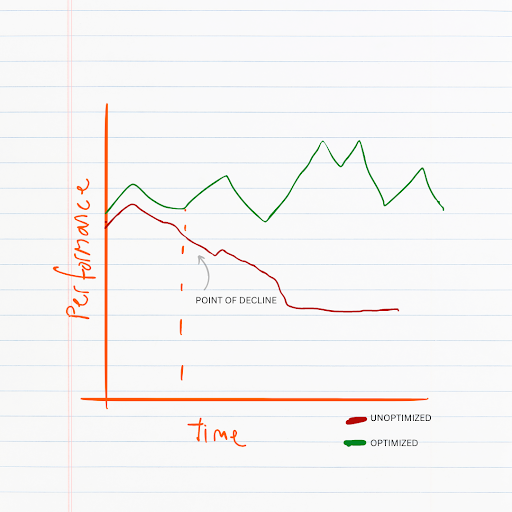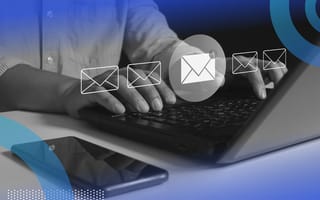“Great products sell themselves,” is a comforting myth for the bootstrapped founder. But any B2B marketer worth their paycheck knows products only get called great after you’ve put a lot of work into getting people’s attention.
When someone signs up for your free trial or freemium plan, you’ve got their attention. But not for long.
On average, 83 percent of your new signups never reach product adoption, according to a report from UserPilot. And, honestly, who can blame them? No matter how much they might want what you’re selling, life gets busy and other priorities take place.
How do you turn that initial intent and momentum into recurring revenue? Easy: welcome emails.
6 Tactics to Improve Welcome Emails
- Go beyond the voice of customer (VoC).
- Map your aha! customer journey.
- Use triggers, not timers.
- Personalize the welcome emails with data.
- Track these anti-guesswork metrics.
- Make testing a recurring task.
Your average user checks their email inbox 15 times a day. And you already have their email address.
But when was the last time you looked at your welcome email? Because if it still references COVID-19 or Super Bowl ads that ran two-plus years ago, odds are it goes directly into the trash bin. The average user is drowning in marketing emails. Think about your own inbox; you likely ignored or deleted dozens of marketing emails yesterday, and today more have already taken their place.
This article is going to show you how to create an “overpowered” welcome email sequence that is so effective and compelling, users will actually want to open it, read it and click it.
How to Create an Effective Welcome Email Strategy
Welcome email sequences remind users why they signed up and how they can use your product, app or service to get what they want. They catch users when they’re at their most engaged, creating a sense of commitment to your brand and the outcome you’ve promised to help them achieve.
1. Go Beyond Voice of Customer
Voice of customer (VoC) is collected from testimonials and reviews. The idea is to gather data from your best customers to help you understand their thoughts, feelings and actions. You can use VoC to develop personas, jobs-to-be-done, lead magnets, ads and your brand direction. But VoC has a major flaw — your existing customers are biased towards your product because they need to validate their purchase. As a result, welcome emails built around this data can’t access the deepest motivations and anxieties behind someone choosing to switch from their old habits.
Instead, center your welcome emails around your voice of prospect data (or VoP for short). It’s the feedback you gather from potential customers before they make a purchase or upgrade. VoP will help you understand a new user’s comparisons, anxieties and deal breakers. When you switch to using this data in your welcome email sequences, engagement goes up.
During a sales call, ask your prospects, “What led you to book this call today? Why now and why not last month or next year?” The answer you get will reveal a powerful hook that you can use in subject lines and intros to really remind people of the frustration of inaction.
2. Map Your Aha! Customer Journey
A customer journey map is a staple in every marketer’s toolkit. To create overpowered emails for your welcome sequence, you need to add key aha! moments to that map.
Aha! moments are realizations a new user needs to have to understand your product’s value. They’re commonly referred to as lightbulb thoughts. For example, Slack won’t consider a user (free or paid) fully onboarded until they’ve sent over 2,000 messages which is their final aha! moment. Once those 2,000 messages have been sent, that user’s not going anywhere.
Once you establish this aha, you can improve your welcome email strategy. For example:
- Setting up in-app tracking will allow you to see where people are getting stuck and address that in your onboarding.
- Identifying email trigger events ensures users receive your emails when they’re most relevant.
- Identifying the right engagement metrics ensures sales and support know what to focus on.
3. Use Triggers, Not Timers
Most emails are scheduled on timers, and there’s a massive problem with that. No matter how good your subject line is, you’ll see a drop in performance around the third email. It’s not your copywriter, it’s not your intern, it’s not you: it’s just the reality of timed emails.
That means if you’re currently sending out a standard 12-email welcome sequence, almost 80 percent of those emails are doing nothing. You’re wasting your time trying to get them to perform when you should be focusing on the 20 percent of emails that actually work. I recommend you turn them off today: a big move, but one that opens the playing field for better, more relevant emails.
Here’s when you should be triggering a three-part micro sequence:
- The user takes an action in-app.
- The user doesn’t take action in-app or in-email, such as when their trial expires.
- The user reaches a new aha! moment in their customer journey.
- The user interacts with your website content.
- The user clicks a CTA.
4. Personalize Your Welcome Emails Using Data
Most people are happy to hand over data for personalized experiences, according to a HubSport marketing report. Further, Salesforce reports that 97 percent of marketers saw better results thanks to personalization.
People are asking for experiences that are relevant to them. Give the people what they want. You can personalize your emails using:
- Audience segmentation
- In-email conditional content based on tags
- Data from other sources.
A simple but effective example of email personalization is using personal information to tailor subject lines. For example, an accounting software company that serves small businesses might have a subject line like “Your [business] taxes done.” To personalize it, they’ll swap out “business” for the specific type of business. One of their subject lines might read “Your food truck’s taxes done” or “your restaurant’s taxes done” depending on the individual reading the email.
Personalization is highly effective, but there is a line. One company experimented with just how personalized they could make their emails to their customers. They created an automation that would track the weather of each user’s location. When it was rainy, it’d fire off an email that said something along the lines of, “It’s raining, it’s the perfect time to update your account.” As you can imagine, folks were a little perturbed. Just because the tracking and data exist, doesn’t mean you should always use it!
5. Track These Anti-Guesswork Metrics
Most people track their welcome email’s open rate and click-through rate. They also track a few lagging indicators like the free-to-paid conversion rate and monthly recurring revenue (MRR). But that still leaves a lot of guesswork on the table for what’s working in your emails and what’s not.
Add the following metrics to your tracking software so you can avoid guessing in favor of proving or disproving your hypothesis:
- Cohort-based engagement: How frequently people log back in.
- Cohort-based time-to-value: The length of time they take to achieve what you identify as value.
- Cohort-based retention.
- Your key product adoption indicator: The quantitative indicator that tracks adoption.
- Your Aha! journey stages
By using the data you’re generating from your VoP, your aha! checkpoints, triggers and personalization, you can finally know what works and what doesn’t. And that means your welcome emails are about to evolve into the most optimized, valuable versions of themselves possible. Now, you have the Ivy League graduates of the email world.
6. Make Testing a Recurring Task
You know that your audience is always shifting and that your product is always getting updates. That means you should check your welcome emails every three months, adjusting and updating them to keep up performance.
If you don’t, then your welcome email’s performance will decline as time goes by, eventually leveling out at a level that’s far below industry benchmarks.

By running tests on a regular basis, you’ll keep your welcome emails up to date and performing as much as possible. Which results in better product engagement statistics in the long-term, leading to organic growth.
How an Improved Welcome Email Strategy Can Boost Revenue
At the start of this article, I asked when you last looked at your welcome email. There’s a wealth of data that can have very real implications for your revenue by increasing your free to paid conversion rate. Companies like Hubspot have seen a 15 percent increase in retention which could impact MRR by as much as 50 percent, according to research from the book Product-Led Onboarding. So before you move on with your day, do a quick calculation about what a poorly performing welcome email could be costing you every month just in lost upgrades.





